#also i used wheat flour not rice
Text
Homemade Yogurt Sponge-Cake SPA/ENG


@cannibal-in-a-can requested the recipe for this so here it is. (I was already planning on sharing it but I got excited that someone asked for it :] )
Additionally to what's in the recipe, there are elements that you can change (you could do this with almost any baking recipe), for example: you can use candied fruits instead of chocolate chips, or use brown sugar instead of the common sugar. You can put a little bit more of sugar than what the recipe indicates if you prefer it more sweet or on the contrary put a bit less.
The important elements of this cake (and most cakes) are the yogurt, eggs, yeast, flour, oil and carrot. You can add extracts, if you are celiac you perfectly can change the wheat flour with cornflour or rice flour (the rice one's a little better but with corn also taste good).
Text only version under the cut
ESPAÑOL/SPANISH
Bizcocho de Yogurt
Ingredientes:
Yogurt (limón/ natural) - 1 (usar recipiente para medir ingredientes)
Huevos - 3
Impulsor (levadura) - 15g
Harina - 3 medidas
Azúcar - 1 medida
Aceite de girasol - 1 medida
Ralladura de zanahoria - 2 medidas (o solo échale una zanahoria)
Pepitas de chocolate (opcional) - 1 medida
Elaboración:
Batir los huevos con el azúcar.
Añadir el yogurt y mezclar.
Añadir el aceite y mezclar.
Añadir la harina tamizada con el impulsor y mezclar bien.
Añadir la ralladura (y las pepitas) y mezclar.
Engrasar y enharinar el molde, verter la mezcla en el molde.
Precalentar el horno 180º C (360º F) hornear 30-40 mins.
Nota adicional:
Puedes usar yogurt griego, pero recomendaría añadir 1-2 cucharaditas de limón o extracto de vainilla.
-
INGLÉS/ENGLISH
Yogurt Sponge-Cake
Ingredients:
Yogurt (lemon/natural) - 1 (use the recipient to measure the ingredients)
Eggs - 3
Yeast (leaven) - 15g
Flour - 3 measures
Sugar - 1 measure
Sunflower oil - 1 measure
Grated carrot - 2 measure (or just one carrot)
Chocolate chips (optional) - 1 measure
Elaboration:
Beat the eggs with the sugar.
Add the yogurt and mix.
Add the oil and mix.
Add the flour sifted together with the yeast and mix well.
Add the grated carrot (and chocolate chips) and mix.
Grease and flour the mold, pour the mixture into the mold.
Preheat the oven 180º C (360º F) bake 30-40 mins.
Additional note:
You can use greek yogurt but I would recommend adding 1-2 teaspoons of lemon or vanilla extract.
#lyna stuff#recipe#sponge cake recipe#receta de bizcocho#bizcocho#sponge cake#I spend the whole night awake making this because I thought it wouldn't take too long :')#I haven't gone to sleep yet
33 notes
·
View notes
Text
How to Cook Cheap Staples:
I recently learned that in the USA, on average, each person eats about 1,670 calories per day of just 4 foods: wheat, corn, rice and soy.
Wheat, corn, rice and soy also happen to be some of the cheapest foods available in US grocery stores. If you buy them as wheat flour, corn meal, rice, and soybean oil. If you buy them as bread, soda, rice cakes, and fried foods, they can also be some of the most expensive.
Based on the least expensive versions of these staple crops available on Amazon (because I didn't want to get off the couch to go to the store for you all), you can get 23,380 calories (the average 1,670 calories per day for 2 weeks) in 5lb of brown rice ($6.20), 5lb of wheat flour ($2.49), 2lb corn meal ($2.98), and 32oz of soybean oil ($6.48).
This means if you make all your own staple foods, 3/4 of your calories could be taken care of for about $9/week. You could even go cheaper than this if you buy white rice. I just threw the brown stuff in there for flair and fiber.
Here's how to cook your staples:
Yeast Bread Loaf
Quick Bread Loaf
Tortillas
Pancakes
Fresh Pasta
Hand Pie/Pierogi/Dumpling Dough
Polenta (don't need the cheese or butter)
Cornbread (can replace butter with oil and buttermilk with milk or water)
Corn Cakes
Tortillas (masa- this is different than cornmeal)
Tamale dough (masa)
Steamed Rice
Congee
Rice Pudding
Rice Cake
If you're trying to save money, shoot for a meal plan that basically includes your staples as the primary food, and adorn with your protein and vegetables. That means, say, a bowl of polenta with tomato-beef sauce. Or rice with black beans, onions, peppers, and spices. Keep in mind that since your staples have been taken care of, you just need about 400 calories in legumes, meat, fruit, and vegetables per day to meet a 2,000-calorie target. That's pretty much an apple and peanut butter for breakfast, a little tomato-beef sauce at lunch, and a handful of beans flavored with onions, bacon, and peppers at dinner.
If that sounds like you're eating mostly starch and fat, you're right, but technically if you're the average American you're already doing that. This is just doing it cheaper.
76 notes
·
View notes
Text
Crystalline Gala Cuisine
Been a bit since I made a festival cuisine, and since my old ones have been circulating, I guiltily figured I should make one for the Gala before it ends. Gaolers and Tundras are both herbivores (though Gaolers also eat meat), but I headcanon that like most herbivores they will opportunistically eat fish, insects, and meat when given the chance. The dishes have a bit more mixing than the previous cuisine; in the Icefield you eat what you can and as much as you can to survive. Potato Onions are my replacement for potatos, because FR needs potatoes (and citrus and tomatoes and wheat and rice and spices).
Seeker Stew- originally a stew of necessity for traveling Seekers, it was made of dried Sea Grass, small Cragside Mussels, canned Common Minnows, Sour Elk milk, and spoiled Turnips. The dish was transformed back home, using fresh Spinach, meaty Olympia Oysters, Jumbo Shrimp, new Potato Onions, and…sour Snowfall Elk milk. Funk is flavor!
Shalefin in a Fur Coat- this uniquely named dish is a layered salad, like the layers of a Tundra fur coat. It is made of finely sliced pickled Shalefin fillets, grated Potato Onion, Gradish, and Honeycrisp Apple, and chopped hard-boiled Flecked Bushrunner eggs. The key binding ingredient is a flavorful mayonnaise made of Elk tallow, Dappled Clucker yolks, and dill.
Bear in a Cave Dumplings-a favorite of the Fae scholars of the Frozen Sanctum. It is a boiled or fried Potato Onion dumpling filled with fried Wooly Bear, Wild Onion, and Dryad's Saddle. It can be served with melted Elk milk butter and Winter’s Delight jam or a white sauce spiced with dried Dusky Mealworm and imported Golden Pepper.
Tundra Grub- a dish named after the main protein of the dish: a sausage filled with Tundra Grub meat, Longneck-grown oats, and Elk blood. The sausage is fried along with strips of Tundra Cactus before being added to an earthy brown sauce of Mycena Mushroom and Earthworms. It is typically served with an unleavened flatbread made of rye or Longneck oats, or a mash of Potato Onion.
Woodland Turkey Dinner- this was once a seasonal dish, but now is common year-round. While the star of the dinner is the roasted Woodland Turkey, the side dishes are just as essential. The most common is: Deep Sea Lobster and Jumbo Shrimp stuffing, roasted Winter Brussel Sprouts with a Superberry vinegarette, Tundra Grub and Potato Onion mash with Mycena Mushroom gravy, and Stonecorn rolls with Elk cheese and White Lace Honeybee honey. And last but not least, a Cinnamon and Honeycrisp Apple pie. A heavy dinner said to put even Sentinels to sleep!
Trunk Cheese- not actually cheese, but a cold meat dish made of fresh Bullephant Trunk (or Mammophant, though it is not as tasty). The meat of the trunk is removed and cooked in a mix of spices and Wild Onion, and then poured and set with gelatin in the skin of the trunk. Slices are cut from the trunk and served upon rye bread with strong Wild Mustard and pickled Gradish.
Edamame Soup and Pancakes- a popular yet odd combination of savory and sweet. This dish features a Chilled Edamame soup (heated of course, the chilled variety of plants grow better in the hot houses of Icefield) with large chunks of smokey Elk bacon, a sprinkle of thyme, and a dollop of Wild Mustard. The pancakes are made of nutty and mildly sweet Amaranth flour and served with Winter’s Delight jam. The soup is traditionally dished with a silver spoon, after a mighty Tundra king was poisoned by his favorite soup.
Warden’s Delight- a dessert, a snack, a spread upon rye bread, and a delight to every hatchie. It is a mix of Elk tallow, Spotted Seal or Wooly Walrus oil, fresh snow, and Winter’s Delight. As the mixture is whipped into fluffy peaks, it is traditional to sing “Warden’s Delight to fight off the night, no Shade or beast shall fill my sight. Drive away the hunger, drive away the cold, fill my belly and make me bold.”
Frozen Bouquet- flowers are rarity in the Southern Icefield, but this bouquet is made from flash-frozen flowers and fruits. After thawing they are quickly coated in a thin layer of crystalized maple syrup and then arranged into a bouquet. Often the bouquets have hidden meanings like Pretty Pink Mums for courting. Winterbelle for strength, and Wolfsbane for warning. But what every Tundra fears the most is a bouquet of Black Tulips.
Crisp Morning Cider- Vodka is life to Ice Flight, the warmth in one’s chest in a land where winter never ends. And while most drink it “neat”, when rations are low then cocktails are the answer! This drink is a common morning warmer and is a mix of White Lace Honeybee honey with hot water, Vodka, Honeycrisp Apple cider, and Cinnamon.
Boreal Brew-a tea made from the leaves of whatever green tree is available. Birch, Fir, Spruce, and Pine can all be brewed into an astringent tea with a citrus-y aftertaste. Unfortunately, Birch, Fir, and Spruce are typically harvested during Spring-Summer- but Pine is harvested during December. To help remove the bitter taste, Pine can be fermented with sugar for a week to a month (fermentation time depending on temperature) and then filtered and served as cold tea.
38 notes
·
View notes
Note
I wanted a headcanon about Konohagakure so bad!! you are very talented.
thank you so much, dear! Since so much is known about Konoha already, I hope these are what you're looking for
Konohagakure Worldbuilding Headcanon

People
Generally speaking, people from Konoha are seen as polite and even outgoing, but sometimes a little obnoxious when it comes to their rampant patriotism. As the first shinobi village of its kind, there is only so much propaganda a Konoha shinobi can handle before turning a little cocky. Konoha citizens love gossip and are often looking for the newest gossip to furthen their sense of unity. They are a rather collectivist society with everyone having to do their part, and the public court of opinion is often times brutal, men especially are often expected to just 'suck it up' and 'act like a man'.
Politics
The hokage is seen as the highest authority figure in the village, unlike in some villages the general population's trust in the village leader is high. The hokage's decisions aren't really allowed to be questioned, and unlike Kiri citizens who do it behind closed doors, Konoha citizens don't even dare to do that. Konoha has a mixed economy with quite a lot of the shinobi income going directly to the village. There is some basic healthcare, but only covers the bare necessities, and better, high quality treatments have to be paid out of pocket. The laguage spoken in Konoha and the fire country (Japanese) is the most spoken language and taught in the other villages as the standard foreign language. It is also the reason why the Kage offices in the different villages have the kanji for the different elements in front of them - to make it easier to find for foreigners. As a second foreign language, people often choose the Kumo language.

Flora
Konoha -and the fire country in general- typically have very bright, warm weather. In the south, there are agonizingly hot summers - snowy winters being a rarity. Konoha is surrounded by dense, lush mixed forest land which serves as a habitat for a wide range of plants and herbs - some of them even having medicinal uses. Although mushrooms are commonly found in the Konoha forests, most of them are poisonous and should not be eaten.
Fauna
The forests are filled to the brim with many different animals, the most commonly found ones being wolves, eagles, deer, boar, pheasants and wild cats. Deer are often hunted and their meat is exported into different coutries as a delicacy. On the rarer side, tigers and bears can be found as well, but they typically stick to themselves. Ever since Konoha has been growing in population, some animals have been pushed out of their habitat and started to coexist with the citizens.

Food
Meat
To secure dinner in Kiri, you can just go fishing. And to secure dinner in Konoha, you can just go hunting. Seriously. Meat, especially venison, is the preferred protein source of Konoha shinobi. However, if you ask a Konoha shinobi what they think of Sungakure and their habit of turning any meat they find into jerky, they would be horrified. Grilling meat is the most preferred method of preparing meat, closely followed by frying it.
Ramen
Due to cultural influences from Uzushiogakure, ramen, including instant ramen, have grown in popularity over the decades. Next to rice, wheat is the preferred source of carbs here. Funnily enough, most Konoha shinobi prefer whole grain over white flour. To each their own, I guess.
Baked goods and confectionary
Konoha has quite a few café's and bakeries that offer many little desserts. But I have to warn you: "Buttercream" in Konoha often just means whipped cream - very different compared to the thick and buttery goodness Kumo shinobi are used to. The most popular baked good in Konoha is the Baumkuchen, frequently enjoyed by sweet tooths such as Itachi Uchiha, Hinata Hyuga and Ibiki Morino.
#naruto#naruto shippuden#naruto headcanons#naruto scenarios#naruto imagines#naruto fanfiction#konoha#hidden leaf village#naruto worldbuilding#naruto meta
37 notes
·
View notes
Text



Containers of food in TJK's Montana cabin + segment from a 2001 interview with the Blackfoot Valley Dispatch newspaper
BVD: I see… Well, back on your representative day—you mentioned some of what you might eat. What was our diet like in general? What would you eat on a typical day?
TJK: This varied so much with the season…. Between 1975 and 1983 I would buy flour, rice, rolled oats, sugar, cornmeal, cooking oil, and powdered milk, and a modest amount of canned fruit and/or tomatoes for the winter. I would eat maybe one can every other day through the cold season. I would eat a small amount of canned fish and dried fruit. Other than that almost everything I ate was wild or grown in my garden. I ate deer, elk, snowshoe hare, pine squirrel, three kinds of grouse, and porcupines, and occasionally ducks, rockchucks, muskrats, packrats, weasels, coyotes, an owl killed by accident—I would never kill an owl intentionally—deer mice, and grasshoppers, huckleberries, soapberries, red twinberries, black twinberries, gooseberries, two kinds of black currants, raspberries, strawberries, Oregon grapes, choke cherries, and rose hips. Starchy roots I ate were camas, yampa, bitterroot and Lomatium, also sprint beauty… I also ate a few minor kinds of roots and a couple of dozen kinds of wild greens. During May and June, before each meal I would eat a salad, often quite a large salad, by just strolling around my property, picking a bit of this and that, and popping it into my mouth. In a few cases I ground up edible seeds and used them for bread. But grinding them was excessively time consuming. I had no hand-mill, and ground them on a rock. In my garden I grew potatoes, parsnips, beets, onions, two kinds of carrots, spinach, radishes, broccoli, and on occasion orach, Jerusalem artichoke, and turnips.
I would dry wild greens and garden vegetables, and sometimes berries, for use in the winter. But for my starchy foods I relied mainly on potatoes and on store-bought staples such as flour, rice, et cetera. Wild starchy roots are scanty up in the high country. Bitterroot and camas are abundant in places in the lower, flat areas, but these are mostly private land and presumably the ranchers wouldn’t want me digging up their meadows to get these foods. In the winters I used to use a tea made from the needles of Douglas fir as a source of vitamin C.
My last winter in Montana, 1995-1996, I was hard up. But when you have to dispense with the things that the system provides, it’s surprising how well you can do by improvising on your own. I had no commercial fruits or vegetables, whether fresh, dried, or canned, but I had plenty of my own dried vegetables. I had some dried black currants and rhubarb, and I had squirrels and rabbits for meat. The commercial stuff I had was just flour—whole wheat and white—cooking oil, sugar, and I think I had a scanty supply of rice. I don’t recall whether I had any oats or cornmeal. I do know that the little powdered milk that I had soon run out and I was using plaster of Paris—dental—as a source of calcium. When that ran out I was planning to use either burnt, pulverized rabbit bones, or pulverized limestone. But I did alright, I enjoyed my meals, and it was a good winter.
BVD: What was your favorite wild food?
TJK: Probably the tastiest wild food in the Lincoln area is partridge berries, a tiny species of Vaccinium—the blueberry genus—that grows at high altitudes. The berries are so tiny that it may take an hour to pick a cupful, but the flavor is superb. Apart from those, my favorite foods are huckleberries, yampa, and the livers of deer, snowshoe rabbit, and porcupines.
BVD: Did you have any favorite meals that you prepared?
TJK: I didn’t have any standard meals, since I just ate what was available at a given time. Generally speaking, my best meals were the stews that contained meat, vegetables, and some starchy food such as potatoes, rice, noodles, or roots such as yampa.
BVD: Would you eat your meals outdoors?
TJK: I seldom did that. I usually ate indoors, at my table in the cabin… When I was done eating, I would sometimes sit back in my chair with my feet up on the table and just gaze out the window for a while…
22 notes
·
View notes
Text
Sooo I was asked about this, here it goes
I'm not a pro, and it's not the 'real' mockup KFC recipe but the one I adapted because I can't use all the spices or quantities because otherwise my dad and bro would cry.
You need:
Chicken (duh), I use breast filets that I then cut up in strips, but I guess as long as they're not too thick you can cut them however. Boneless chicken thighs might work too.
Rice flour. Why rice and not normal wheat? I have a slight intolerance to gluten so I try to cut down on it. And it also makes the chicken crunchier and less oily.
3 whisked eggs
Panko crumbs. Again, I use panko because it's crunchier and less oily.
Spices: garlic salt, black pepper, white pepper, paprika (sweet and spicy), ginger, thyme, basil, oregano, parsley

A pan with oil, pipping hot. Remember to lower the temperature as you fry to make sure the chicken is done before the outside burns

Method:
Coat the chicken in the flour, then in the egg, then in panko crumbs, and into the oil

35 notes
·
View notes
Note
"It's like an empanada, but on bread." DeepL translates this as "Es como una empanada, pero de pan." Not "en pan" or "encima de pan", or even "con pan". Any idea why this would be "de"? What other things follow this pattern? Thanks!
This actually took longer to answer than I thought because so much of what I was thinking is just based on instinct and what I've seen
-
I think it's a limitation of the translation
First, empanada is hard to translate properly because empanado/a means "breaded", or it refers to something that is covered with bread or has bread on all sides like a dumpling, a pot pie, etc. All can come out as empanado/a
Secondly, I personally would not write it that way because empanada de pan kind of sounds like either you're specifically talking about the dough or that the bread is a star here. My instinct is like that reads as if you're talking about pan as an ingredient... OR I could maybe see it as meaning "made with wheat flour" rather than corn masa
Because third, de (algo) is typically how you describe food where it's the main star... like helado de cereza means "cherry ice cream" like that's the main taste; and if you said helado con cereza(s) "ice cream with cherries" I would assume that they were either mixed after the ice cream was made or there's a cherry on top
A lot of things will list the main ingredient that way like sopa de tomate "tomato soup" rather than a "soup with tomato", or caldo de res "beef broth/soup"
If I said empanada de pollo I would think "okay it's an empanada and the main ingredient is chicken", rather than something like empanada de cebolla y queso "cheese and onion empanada", or una tortilla de jamón y queso "ham and cheese omelet"
(But this does sometimes depend; I've seen arepa con queso more than I've seen arepa de queso but I think both make sense? And some specific foods are more one specific phrase like arroz con leche is literally "rice with milk" but it's the standard expression for "rice pudding")
...
Me personally the way I'm reading it is that you're trying to say that it tastes like the filling of an empanada [el relleno is "filling"], but on bread
In which case I would say es como (el relleno de) una empanada sobre pan because sobre "on/on top of" is more generally how you talk about sandwiches on a menu
You can also then specify some people say like sobre pan de trigo "on wheat bread", so a menu might be like pavo y queso sobre pan de trigo "turkey and cheese on wheat bread" or un reuben sobre pan de centeno "a reuben on rye bread"
...
This may be my own personal understanding, but when it comes to food de + algo is like "that's the main flavor", con + algo makes it seem like something comes with it or it accompanies it... And I'm not sure I would use encima "on top of"
encima makes it seem like it was placed on top, rather than "it is on" the way like una cereza encima del postre "a cherry on top of the dessert" or con una cereza encima "with a cherry on top"... it feels more like I am actively pointing out its position, and with food specifically it reads as "this is a garnish" to me but that could just be me
So if I saw empanada con pan I would think "this is an empanada and they're giving me bread too", but if I saw empanada de pan my instinct would be thinking it's like a Thanksgiving bread stuffing inside of fried dough
14 notes
·
View notes
Text
Tumblr came in absolutely clutch with recipe recs for me lately, so in the spirit of paying it forward, I return offering a recipe for:
The Best Sweet Potato Casserole You Will Ever Have in Your Life
[plaint text: "The Best Sweet Potato Casserole You Will Ever Have in Your Life."]
courtesy of — if I'm tracing my recipe genealogy correctly — either my great-grandmother's church friend, or some kind of benevolent patron god of brown sugar and root vegetables. With a couple of eggs, it achieves almost a soufflé texture, and it's deliciously sweet but not in the overkill way that keeps me away from some other sweet casseroles.
Are you looking to upstage everyone who's bringing a pie to the family gathering? Do you have a sweet tooth, but not enough of a sweet tooth for those other sweet potato recipes that douse them in an equal mass of heavy syrup or marshmallows? Then this is the casserole for you.
Vegetarian, and easily made gluten-free with substitutions.
Ingredients:
[plain text: "Ingredients".]
3 cups pre-cooked sweet potatoes, slightly mashed
1/4 cup butter
2 eggs, room temperature
1 tsp vanilla extract
3/4 cup brown sugar
Streusel topping:
[Plain text: "Streusel topping".]
3/4 cup brown sugar
1/3 cup butter
1/3 cup flour (any kind will do)
1 cup of a crunchy, salty snack*
*Pecans are listed on the original recipe, but if you're allergic to nuts, try crushed pretzels (small but not totally pulverized pieces). If you can't have wheat either (hi friend!), I used crushed rice chex with a half-teaspoon of kosher salt sprinkled on this year, and it was still S-tier. Truly, I don't think you could go wrong with any plain rice cereal plus extra salt to taste. We love a flexible recipe!
Equipment:
[Plain text: "Equipment".]
9x9 or roughly equivalent baking dish (if dish is bigger, just bake for a slightly shorter time)
At least 1 mixing bowl
Spatula
Fork (for prepping streusel)
Instructions:
[Plain text: "Instructions".]
If you haven't done so already, cook the sweet potatoes until they reach a texture suitable for mashing. This can be done in the microwave in about 10 minutes, give or take depending on settings, but be sure to poke some holes in the skin with a fork before microwaving, so the steam can escape.
Once cooked, remove skins then mash them. Let them return a little closer to room temperature before stirring in the eggs (so the eggs don't immediately cook). Add the butter (1/4 cup, melted), brown sugar (3/4 cup), and vanilla, and stir thoroughly before spreading out evenly in baking dish.
For the streusel, mix brown sugar (3/4 cup) and flour. Cut the butter (1/3 cup) into this mixture; this works best if the butter is slightly cooler than room temperature, but not straight out of the fridge. Use the tines of a fork and the side of a bowl to break the butter apart and mix, until a crumbly texture is reached. Mix in topping of choice, then sprinkle on top of potatoes.
Bake at 300° Fareinheit for 30-45 minutes, uncovered. The streusel should be lightly browned. Best served warm.
Other notes:
[Plain text: "Other notes".]
Cinnamon and its friends (allspice, nutmeg, etc) can be delicious additions to the potatoes and/or the streusel. This dish is sweet enough to function as a dessert, but it's also great as a side to something savory. In terms of prep, the sweet potatoes can be pre-cooked and mashed ahead of time; simply refrigerate until ready.
And that's all! Enjoy!
14 notes
·
View notes
Text
The Dinner Diaries, Day 4 - Knowing Your Limits, Treating Yourself
One of the big things about being a spoonie is knowing your limits and knowing when a treat is not only a good idea but damn near necessary. Even having had days of recovery, I'm still not doing so well after three weeks of nightmare at work.
This is why I keep a small discretionary fund for Emergency Takeaway Dinner. It's not much, but it's enough for maybe once a month or so, depending on the takeaway. My problem is that because I have gluten issues on top of everything else, the types of takeaway I can actually get are ... limited at best. Not entirely cut off, though. A fair few places will do gluten-free options, and if you have anxiety like I do and hate asking for speciality dishes, there are some types of cooking that are gluten-free just by their nature. Here are the three I know about off the top of my head:
Indian: If you avoid samosas and any of the bread options, Indian food is pretty much entirely gluten free. Most of the dishes don't involve flour for thickening the way a lot of sauces do. And even onion bhajis are okay because those use gram flour, which is a type of chickpea flour and naturally gluten-free. I miss naan bread, but at least I can have Indian food (even if the stuff I make at home is much better).
Sushi: While most Japanese food needs to be avoided because of the soy sauce (or, like, breaded things like tempura and katsu), sushi's pretty safe if you make sure to use gluten-free soy sauce (also known as tamari) instead of regular soy sauce. Miso soup is also fine.
Thai: Like Indian, most Thai dishes are naturally gluten-free. They tend to use rice noodles instead of wheat noodles, stuff like that. So by and large, as long as you're avoiding anything breaded and using tamari instead of soy sauce if you want soy sauce on it, Thai's safe.
The options are pretty minimal, but it's better than I thought they were when my gluten issues first started. As for me? Tonight? I haven't had sushi in far too long so I am having some now. I have put in weeks of miserable graft and I deserve raw fish and well-prepared sushi-rice. So if you're feeling like you should treat yourself but struggle to because of gluten issues? Here are some good tips.
13 notes
·
View notes
Text
weird detail that im obsessed with: the north-south grain division in ancient china. this is something i want to see more of in literature so if u want to use this as story ideas be my guest.
Most people assume the staple foods of rice, noodles and buns are eaten interchangeably, but even as late as the 1970s there was a noticeable north-south division of what grains were available due to shipping and climate. For example, when my mum was growing up in shangdong, she only ate rice a few times a year and regarded it as a luxury. (side note: the Colombian exchange was SO interesting in shaping modern china. my dad lived in dongbei, which was super far north and only colonised during the 50s, and the staple crop was potatoes. my mum also ate a ton of corn as it was cheaper than wheat (glutenous corn not sweetcorn.)
south of the yangtze river (and central) -- hot climate, rice was the staple crop, main foods were rice-based noodles/flours/pastries. glutenous rice was rarely eaten by itself and was mainly used in pastries, noodles, ect
north of the yangtze river -- cold climate, wheat was the staple crop. the most common foods were noodles, flatbreads and buns. They were collectively referred to as "bing" during this time. dumplings were invented in the later eastern han but they were for special occasions, e.g. the new year celebration, so people would not be eating them casually.
also also, dairy was not eaten until modern times, in fact, it was associated with steppe nomads and considered a "barbaric" food. i think it would be SO FUNNY if Some Guy was railing against Those Savages drinking that Rancid Goat Excretion and the thing he's talking about turns out to be... fucking yogurt.
#i have a TON of unused factoids from the Han Dynasty so im just going to dump them here. Sorry this is a little northern-centric#ancient china#refs#foods
17 notes
·
View notes
Text
Bread around the world
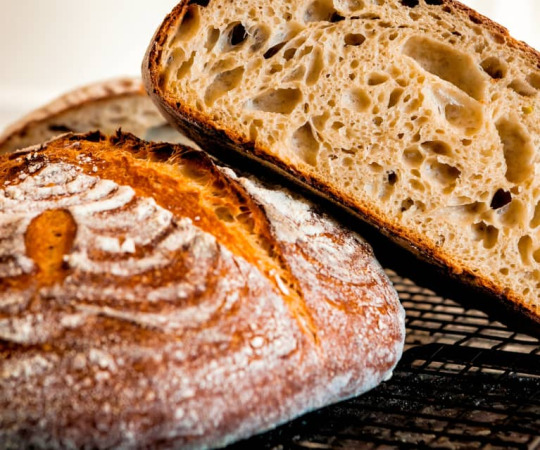
Let me be a bit cliché German today. Let me talk about bread. Because we Germans are fucking obsessed with bread, as it is so often parodied by folks from other countries. And yes, this is true. The rest of the world does not understand why sour dough is so much better than this horrible bland white bread you guys eat!
*coughs*
But... Did you know that bread is a thing that shows up throughout so many cultures and throughout human history in so many different forms?
But for that we gotta talk a moment about what even is bread. Because some folks do define it as something that needs yeast and some sort of corn within the European sense of the word.
A more general definition, though, is that bread is a food created by mixing some sort of flour with a liquid and then cooking this mixture until firm.
Which is what I will go by here. So... let me talk bread.

What little German pride I have asks me to start this off with sourdough bread. Which since the pandemic started a lot of people have learned to make. Instead of using some poor form of yeast, the yeast is won by leaving a very liquid mixture of flour and water (and at times malt) out in the open for a couple of days, so that yeast from the air can settle in the mixture. This mix is then added to more flour and water and kneaded, rested, then kneaded again, to develop it texture. It is then baked as a loaf.
Now, this way of making bread dates back forever. Because we have found old sourdough bread that is almost 6000 years old. It was probably white spread across the ancient world.

The probably most German version of sourdough bread is pumpernickel, which has been made with a very coarse rye flour. In fact the city I live in is quite famous for the pumpernickel bread here.
Funnily enough, pumpernickel was originally the bread of the poor and those, who were doing religious penance, because while it is super healthy, it is a) very cheap to make (not that you would know looking at the prices it is sold by today) and b) not that tasty, as it just has a very, very strong and rather bitter flavour.
But in the middle ages rye was the cheapest kind of corn around. So... pumpernickel was the thing they made.
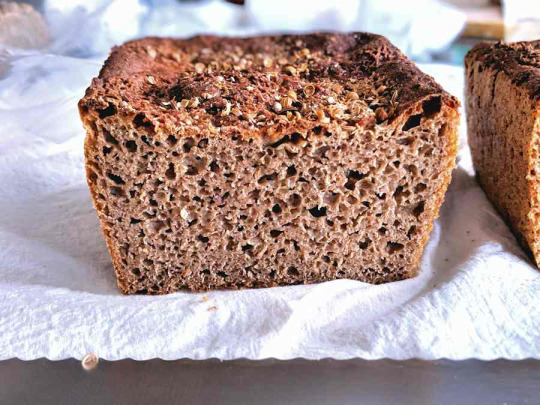
Borodinsky is another rye bread - this one from Russia. Again, rye was for the longest time the cheapest kind of corn over here, so it was most often used in baking bread. The big difference to pumpernickel is, that in borodinsky the rye flour is a lot finer and the bread gets sweatened with malt, so that it does not taste quite as strongly and bitter, as the pumpernickel does.

Funnily enough the Turkish Bazlama flatbread traditionally also is a sourdough bread, as the same process was used as leavening for the bread in this case. If you have ever eaten bazlama, you will know that even though it is a flat bread it is relatively fluffy on the inside. Which comes from the sourdough levening.
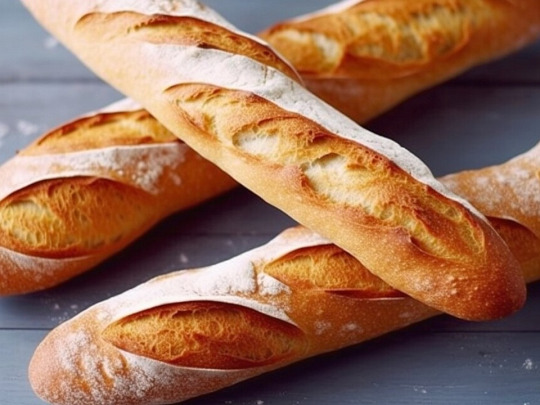
Now, funnily enough: The French often do not have this big thing with sourdough, even though they, too, are quite famous for their breads. But ever since we humans figured out how to isolate yeast, the French basically went like: "Well, if we use pure yeast, the result will be a lot more predictable." Because sourdough has this aspect that it will taste a little different depending on where you created it - at times even dependent on the time of year.
So, baguette is a yeasted bread and it uses fine, white wheat flour, which is a lot nicer in taste than rye.

Now, Japan is of course not a country with a long bread tradition. Mostly because rice usually does not make for a good flour for bread and the like. But ever since bread came over and became popular, they have come up with a few of their own creations. Shokupan - milk bread - is probably the most well known example of this. This, too, is a wheat and yeast bread, but it also uses milk instead of water and is very enriched with all sorts of things, so that it is softer and also a lot sweeter than other breads.
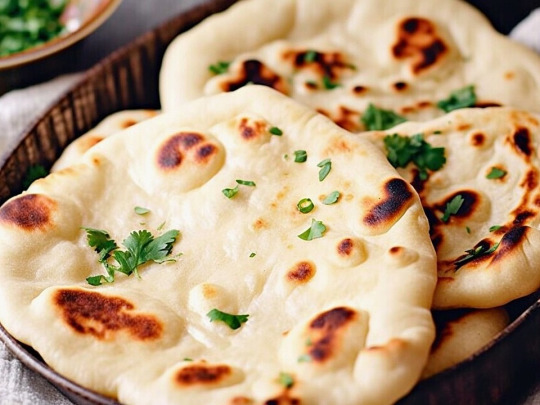
Naan is a bread most probably know from the Indian cuisine, but it is in fact another super old kind of bread as it originates in Mesopotamia. As such it was originally also made as a sourdough, those these days it is often done just with normal yeast as leavening. And it is spread fairly far within the Arabian subcontinent and the Indian subcontinent. The interesting thing is, that it is a flatbread, but it is usually completely oven baked.
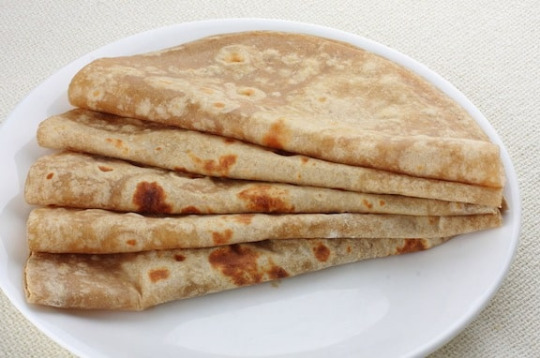
Chipati is an unlevened flat bread that is quite common in eastern Africa. It is usually really thin and is served as a side dish to all sorts of soups and stews, often used to carry those with people dipping the bread in the soup/stew or putting stew onto the bread.

And while we are on the topic of unlevened flat breads: Tortillas are among those, too. They are kinda interesting in so far that, while most tortillas sold these days are wheat based, there is a version around made from maize, too.
But yeah, usually most breads are made with wheat or rye or maybe spelt, because breads... just turn out best, when they have gluten, as gluten helps to develop those fluffy textures we associate with bread. Which is why bread tends to be most common within areas, where they had some access to gluten rich corn. xD
19 notes
·
View notes
Note
this is v sappy but just wanted to say how much i appreciate this blog bc of your gluten free stuff. i’ve had celiacs for almost 8 years now and i still often feel totally beat down by the lack of options out there. it’s really hard to feel inspired to cook when you know it’s gonna taste like shit. like the amount of gf recipes i see that only have you use rice flour as a 1-1 wheat flour replacement makes me wanna rip my hair out lol. but your food always looks so good and it’s so refreshing to be inspired and actually *want* to cook something that would actually be good for me. so, genuinely, thank you for that. keep on truckin <3 also ps what kind of flour do u like to use for your cookies? do you use a blend depending on the flavors or something singular like almond flour?
awwwww this is so sweet! I obviously have endless emotions towards food, restriction, and accessibility <3
in my cookies I tend to use sweet rice flour, and in my other bakes like scones and cakes I tend to do mixes, sometimes premade, but lots of personal blends too that I experiment with!!! I don't use a lot of almond flour because I've found it effects my stomach but I really like cassava + sweet rice the best
11 notes
·
View notes
Text

[ID: A bowl full of fried rice, peas, carrots, and seared chicken. End ID.]
Chinese 'chicken' fried rice / 鸡肉炒饭
Soy sauce, toasted sesame oil, white pepper, and kala namak produce a rich, savory, umami base for whatever vegetables you have on hand in this vegan version of a classic fried rice recipe. I give instructions for adding marinated 'chicken' and/or 'egg', but this recipe is just as delicious when made only with carrots and peas.
Mush often comes of attempting to make fried rice from rice that's been cooked according to package directions; crowded pans or unevenly heated woks also lead to underwhelming results. This recipe specifies the perfect ratio of rice to water by weight (though volumetric measurements are also provided), and gives a few tips for producing even, separated, well-fried rice grains.
Patreon | Tip jar
Serves 8.
INGREDIENTS:
For the chicken (optional):
250-300g unbreaded vegan chicken substitute (I used Gardein)
2 tbsp Chinese-style light soy sauce
1 Tbsp Shaoxing wine (or substitute dry sherry or mirin, or a "mirin-style condiment" for a version with less alcohol)
1 tsp cornstarch
Crack of black pepper
For the dish:
285g (1 1/2 cup) long-grain white rice
95g (1/2 cup) jasmine rice
About 608g (2 1/2 cups) water
2 carrots, diced
3 scallions, sliced
1/2 cup peas
3 shallots, diced
1-inch chunk ginger (10g), crushed and chopped
6 cloves garlic, julienned
1/4 cup Chinese-style light soy sauce
1 tbsp toasted sesame oil
1 Tbsp vegetarian oyster sauce (optional)
1 tsp kala namak (black salt; for an eggy taste, if you're not using a scrambled egg substitute)
Several Tbsp refined peanut oil or untoasted sesame oil
2 tsp white peppercorns, toasted and ground
1/2 Tbsp MSG (optional)
10 fl. oz (300 mL) vegan scrambled egg substitute (optional)
About 4 cups of leftover rice may be substituted for the dry rice in this recipe. You can also make this recipe with frozen mixed vegetables or any other vegetables you happen to have on hand (sliced celery, napa cabbage ripped into bite-sized pieces, etc.). Mixing long-grain white and jasmine rice yields a mixture with the firm, separated texture of white and the nutty aroma of jasmine rice; but 380g of long-grain white rice or of jasmine rice may be used instead of a blend of both.
Refined peanut oil (which has a higher smoke point than unrefined) and untoasted sesame oil are standard in Chinese cooking; they have high smoke points, which is a must in oils that will be used at high heats, and impart a pleasant nutty flavor to the final dish.
Chinese-style soy sauce (likely to be sold as "light" or "thin" soy sauce in the US) is distinct from Japanese-style soy sauce (such as Kikkoman's); it uses wheat flour only to aid in fermentation, while Japanese soy sauces owe more of their flavor to toasted wheat. Pearl River Bridge, Amoy, Lee Kum Kee, and Koon Chun's "light" versions are examples of Chinese-style soy sauces--but note that all-purpose soy sauces produced by these brands for export may be Japanese-style.
INSTRUCTIONS:
For the chicken:
1. Mix all marinade ingredients (soy sauce, wine, cornstarch, and black pepper) in a large mixing bowl. Add thawed chicken and stir to coat. Cover and refrigerate while you prep the vegetables.
For the rice:
1. Measure out rice into a large bowl. Rinse it 3-4 times in cool water until the water runs mostly clear to remove excess starch: you can do this by transferring the rice to a mesh strainer that fits closely inside a mixing bowl; filling the bowl with water and lowering the strainer into it, agitating the rice to release excess starch; then lifting the strainer and changing the water.
I always rinse my rice when making rice not intended to be sticky; you may be able to get away with skipping this step, though, if you buy your rice in plastic bags (not permeable cloth ones) and are careful not to add too much water.
2. Add rice and water to a large pot (remove 1 Tbsp from the water measurement per cup of rice if you rinsed it, to account for the water still clinging to the recipe; for this recipe, you'll need 2 1/4 cup + 2 Tbsp).
I recommend using a kitchen scale, if you have one; it enables you to be more precise with the rice to water ratio. Tare out your bowl; weigh your rice (380g total), then rinse it; return it to the bowl (without re-taring) and add water until you reach a total weight of 988g (1.6 times as much water as rice by weight). This automatically and exactly accounts for the amount of water clinging to the rinsed rice.
3. Heat the rice on high until the water begins to boil; reduce the heat to low (or whatever is required to maintain a low simmer), cover the pot, and cook the rice for 15 minutes.
4. Remove the rice from heat without lifting the lid and allow to steam for another 5 minutes.
5. Fluff the rice with a fork or wooden spoon. Spread it out in a single layer on one or two baking trays and leave them uncovered until they cool to room temperature, to allow rice to let off excess steam.
6. For best results, cover and refrigerate the rice for a few hours, or overnight.
For the dish:
1. If you're using a wok on a Western stove, heat it on medium for 10-15 minutes while you prepare your vegetables to encourage even heating (Western stoves are not usually capable of quickly bringing woks to the temperatures best for making fried rice; if the bottom is much hotter than the sides, your rice may not fry well). Otherwise, use a large skillet.
2. Prepare your vegetables. This dish comes together quickly once cooking begins, so it's a good idea to have all your prep work done first.
3. Mix soy sauce, toasted sesame oil, oyster sauce, and kala namak in a small bowl.
4. Add peanut or untoasted sesame oil and raise heat to high. Once wisps of smoke appear, add chicken (leave any extra marinade in the bowl) and sear on both sides. Remove chicken from pan and scramble egg mixture by pouring it into the pan and immediately beginning to stir it, scraping the bottom of the pan occasionally, until firm. Set aside.
5. Add another Tbsp oil to pan and allow to heat. Add as much rice as will just about fit in a single layer (you may need to do this in a few batches) and fry for about five minutes, stirring often, until fragrant and a shade darker. Add more oil and allow it to heat up in between batches of rice.
Having patience during this step (neither crowding the pan nor under-frying the rice) is essential to the flavor and texture of the final dish!
6. Remove rice from pan. Add shallots, ginger, and garlic and cook for about 30 seconds until fragrant.
7. Add rice, chicken, and egg back into pan. Add vegetables and soy sauce mixture and continue to fry until the sauce has thickened and coated the rice, about five minutes.
8. Add white pepper, MSG, and scallions and mix to combine.
Serve hot. Leftovers will keep in the fridge for several days and may be re-fried or microwaved.
#fried rice#vegan#vegan recipe#Chinese#cooking#carrots#shallots#peas#rice#egg#chicken#gluten free#(without the chicken)
53 notes
·
View notes
Note
So I have a medical question that I'm curious about. So I can't eat citrus baked goods without getting a headache, like very specifically citrus baked goods, other fruit baked goods are fine, boiled or roasted citrus food is also fine, but for whatever reason if a citrus fruit is cooked into a baked good like cookies, brownies, cake, or pie to name a few, I get a headache, or I think a migraine? My question is, do you at all know why that is? (I do normally get migraines if that matters)
god i actually have no idea i feel like that's one for the food scientists
is it only with wheat/gluten baked goods? does that also happen with gluten free stuff or if you use, like, rice flour or something
i mean it will be some chemical interaction between the citrus and something in the baked goods that occurs when exposed to heat but fuck knows what
are there any food scientists here
#if it's only baked goods involving gluten then the obvious culprit would be#'citrus (likely the higher concentration of vitamin c???) interacts with gluten when exposed to heat and the result causes migraines'
39 notes
·
View notes
Text
Baking of day
Hello ! For those who are interested, I made a Foccacia with sourdough and yeast (in my own way) today. And guess what ?
I share with you the process
Above all, I work with old wheat flour, and the flour I used today is wholemeal flour. (I can assure you that it works, prove 👇👇)
To get started, you will need the following ingredients :
- Flour (500g)
- Salt (9g)
- Whole grain mustard (50g)
- Yeast (preferably a quality fresh yeast) (25 g)
- Fermented dough (prepared the day before) (100g)
- Sourdough (refreshed the day before) (sourdough can also be an option) (100g)
- Potato flakes (45g)
- Rice flakes (60g)
- Millet flakes (20g)
- Olive oil (125g)
- And of course water (500g)


here : potato flakes, rice flakes and millet flakes in the same container, sourdough and fresh yeast
Step 1 : Pour your water first into the tank. Then the flour, then... other ingredients, except olive oil ! (Save the olive oil for later)



Then, start the kneading, (five minutes on the timer)
Step 2 :
Take a clean bin.

And spread olive oil with faond and on the edges

Practical advice : don’t forget to watch your mix. Because according to the temperature and humidity of the room, but also flour. You can also have small surprises, like me today :
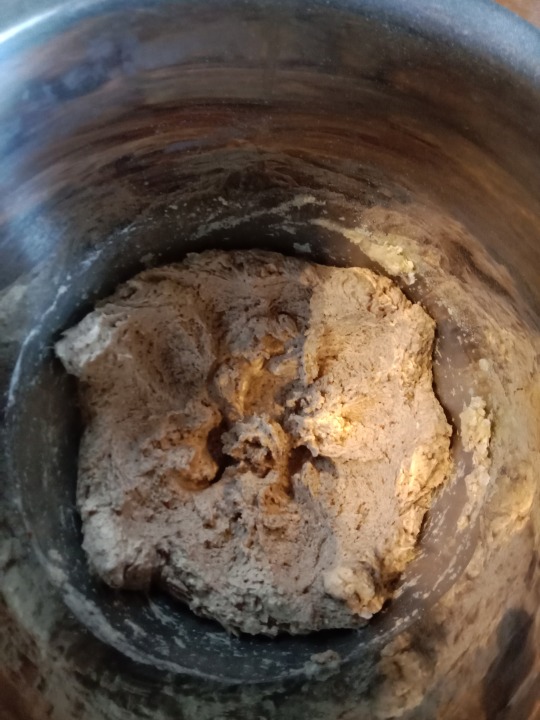

You see ? The dough did not mix well. But it doesn’t matter, peel the dough with a horn (yes, that’s what we call it), and put it back in the mix. (if the five minutes have already passed, add three minutes)
Step 3 :
Take your 125g of olive oil and pour it during kneading (do not put all at once, allow time for the dough to drink the oil)


P.A : If at the end of kneading, the dough seems too soft, almost liquid, add a little flour.
Step 4 :
Put your mixed dough in the oiled bin
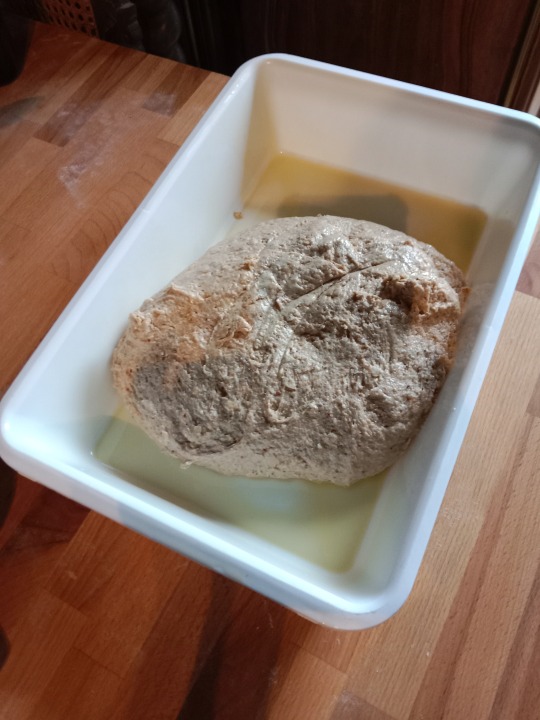
Then, you will make flaps (so fold the dough on itself)


Well, there I show you the process with one hand (and I can assure you that it is not easy... 😬)
Step 5 :
Protect the dough by covering it with a plasticized film. Like here👇

Then, let it rest for 30 minutes at room temperature.
And what can you do in the meantime ? Well : dishes, friends ! Go, go, go !
After 30 minutes, if the dough seems too soft, redo a flap. Then let the dough rest for 60 minutes.
Step 6 :
After all this waiting time, take a cooking hob, lay a sheet of baking paper, then... oil it (Not too much, otherwise it will no longer be a sheet of baking paper, but a sheet of wallpaper to stick to the wall.) (Don’t do that either.)
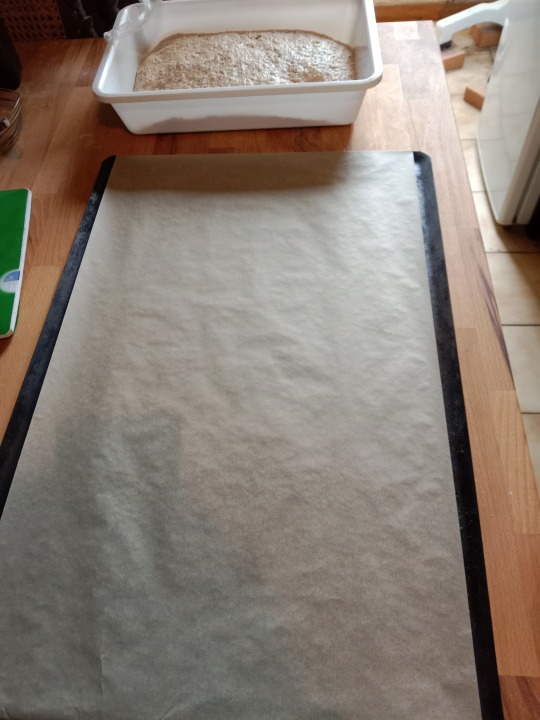



After, spread the dough on the cooking hob. Then, cover it with a plasticized film. After that, you’ll let it swell for an hour and a half. (It will not swell much, do not expect to see a pillow on the cooking hob)
Step 7 :
(I hope you have not thrown away or put away the olive oil, because you will still need it.)
Preheat your oven to 250 degrees.
In a small container, pour a little olive oil, and dip your fingertips into it to make small holes in the dough, as you see here.

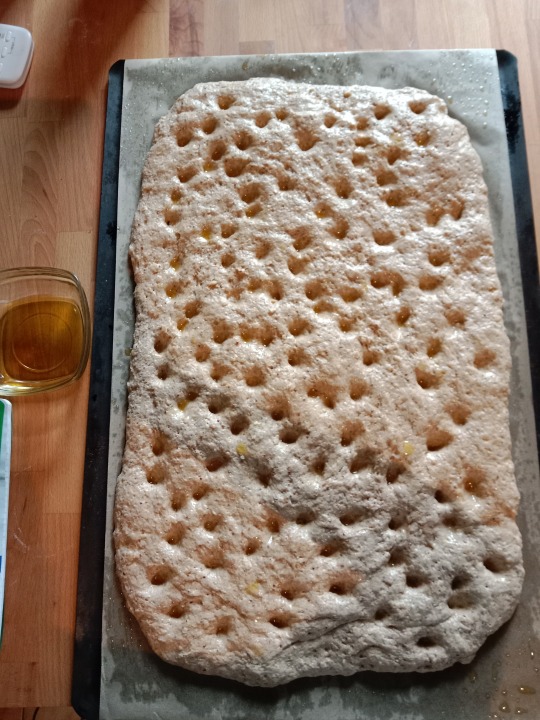

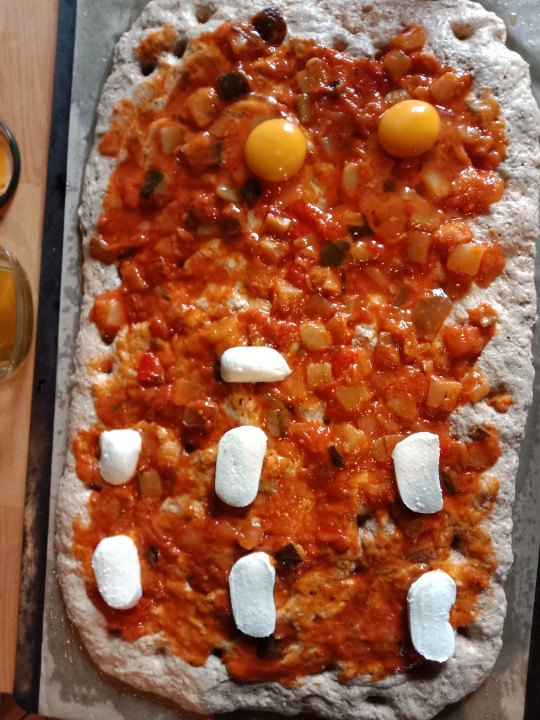


The filling can be according to your preferences, for my part, I put ratatouille, mozarella, eggs (because not enough mozarella), black olives and herbs (oregano and thyme).
Then put your foccacia in the oven, then lower the temperature to 240 degrees.
Cooking time varies depending on the oven, but usually cooking is 17 to 20 minutes. And voilà !
Enjoy your meal !
3 notes
·
View notes
Text
Worldbuilding: The Quest for Pizza
No matter where in time and space you are, foods that taste like home make life so much better. There are a lot of American comfort foods that might be replicable in 1600s Northeast Asia, if you knew what you were doing. Off the top of my head, some classics include: apple pie, mac and cheese, jambalaya, spaghetti, hamburgers and French fries, and pizza.
Apple pie would be one of the easiest to pull off. Pastries are pretty much a thing everywhere you’ve got wheat flour, sugar’s available, and apples can be found all over given they went in both directions down the Silk Road, travelers knowing a good thing when they bit it. A little cinnamon for spice would be the most expensive part, but it’d be available; the spice trade is up and running all over the place. Give a local cook a good description, or ask for some kitchen time, and a slice of hot apple pie is entirely possible.
Mac and cheese should also be possible, though you may have to get a bit more creative. Noodles, definitely available. Macaroni or shell-style? That, you would have to describe a dough press for. Or just get flat fettuccini-style noodles and go with it. It’s probably easier to get yogurt than milk, but you can get cheese... if you’re in a northern area influenced by the Mongols and related tribes. So, if you’re in or around Manchuria (named for the Manchus), you’ve got it. It won’t be cheddar, not unless you wrangle that off some English traders, but actual water-buffalo mozzarella is a possibility! And if you like a little chili powder to add a hint of heat? So long as it’s post-1520s, you’re in luck. The Portuguese brought chilis along in their galleys. We can date chilis in China to somewhere between 1520-1550s, in Japan by the 1570s, and they were widespread in Korea by 1614; likely brought over by Hideyoshi’s invasion of 1592-1598.
Which leads us to jambalaya. Chilis, meat, rice, sausage, basil, oregano, garlic, onions, cilantro, and a lot of recipes call for tomatoes. Garlic and onions are ubiquitous in Eurasia; oregano and coriander (cilantro) are also in Asia, and basil’s originally from India. Tomatoes... yes, they would be there, European trade brought them in the 1500s too. But most people thought they were decorative, not so much food. You can get them. Convincing other people to eat them might take a bit.
With all those ingredients, spaghetti should be a given. Mangia!
Hamburgers and French fries, though - likely not. Oh, you can do ground meat, ketchup, and pickles, but potatoes didn’t historically get to China until almost the very end of the Ming Dynasty, brought by the Dutch right as the Manchus crashed the party and created the Qing Dynasty. Korean relations with the Manchus were touchy. Which might explain why Korea historically didn’t get potatoes until the 1800s.
But the trickiest of all would be pizza, at least if you like the classic ham, onions, green peppers and cheese. There’s some disagreement on exactly when bell peppers (almost no heat) were created from chili peppers (varying degrees of heat). Jefferson may have encountered a variety in the 1800s. But most people trace them back to Hungary in the 1920s. That’s right, green bell peppers in the 1600s would be historically inaccurate.
...I can guarantee you if Jason ever gets back to modern Earth, he’s raiding a seed catalog. Pizza!
18 notes
·
View notes